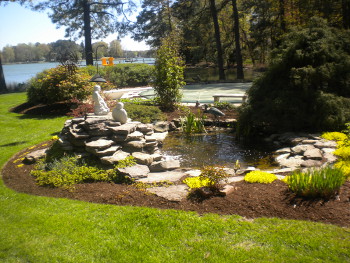

We apply a wide variety of locally available mulches for top dressing and plant protection purposes. Pine straw mulch is also available for a truly unique, natural look.
Mulching trees, shrubbery and landscaped beds is a good method of reducing maintenance and keeping plants healthy. Mulch helps to conserve moisture, so that less water is used to keep plants alive during the heat of the summer.
Various types of mulches help keep the soil well aerated by reducing soil compaction that results when raindrops hit the soil. They also reduce water runoff and soil erosion. They help maintain a more uniform soil temperature (warmer in the winter and cooler in the summer) and promote the growth of soil microorganisms and earth worms.
Mulches eliminate mowing around trees and shrubs and provide a physical barrier that prevents damage from lawn mowers and weed trimmers. A 2-4 inch layer (after settling) is adequate to prevent most weed seeds from germinating. Mulch should be applied to a weed-free soil surface. Just covering a weedy area won't help at all.
 Sound convincing? We just can't say enough about the benefits of organic mulch, as long as it's applied properly.
Sound convincing? We just can't say enough about the benefits of organic mulch, as long as it's applied properly.
Organic mulches decompose with time, releasing small amounts of nutrients and organic matter to the soil. Some gardeners feel that the more mulch they use the better; however, the mulch layer can become too deep.
Excessive applications of mulch can result in a situation in which roots are growing in the mulch and not in the soil. Over mulched plants are easily damaged when herbicides and fertilizers are applied and during periods of drought. Mulching an area that is poorly drained can aggravate the condition.
Have you ever seen mulch piled up, "volcano-style" against the base of a tree? It's one of our biggest pet peeves and it's dangerous to the health of your tree. Mulch should never touch the bark of a tree because "girdling roots" will wrap themselves around the tree and slowly choke it to death.
There's a chance you may not need any new mulch. If there's still plenty of mulch in your garden, it may have formed a crust formation on top of the soil. When this happens, we have the tools to easily break up the crust and ‘fluff' the mulch. It visually makes landscaped beds appear as they did when mulch was first applied .